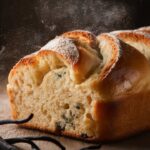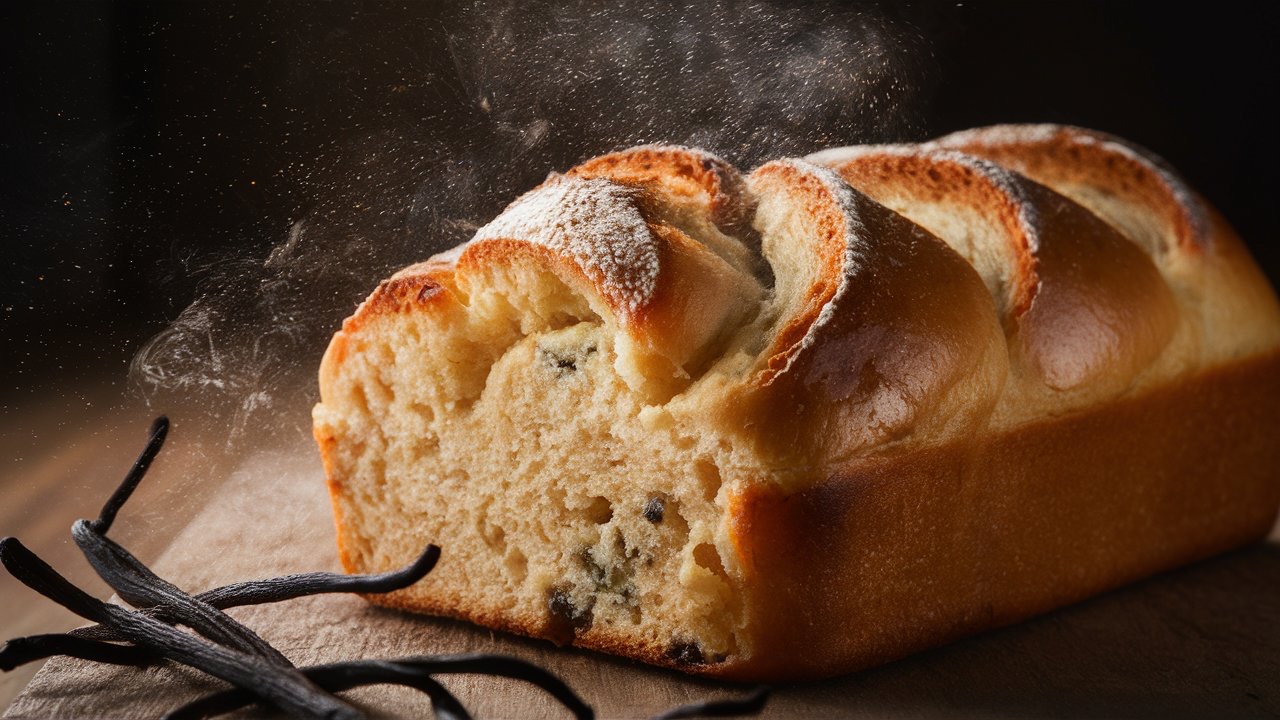I’m here to walk you through on what happens if you add vanilla to a bread recipe. Whether you’re baking something sweet like cinnamon rolls or savory like a classic French bread, understanding how vanilla impacts your final loaf can help you create delicious, flavor-packed breads every time.
Vanilla is a beloved baking ingredient that can enhance the aroma, flavor, and texture of your homemade breads. When you incorporate vanilla into your dough, it infuses the loaf with a subtle sweetness and floral essence that complements both sweet and savory flavors.
Beyond just enhancing the taste, vanilla can also contribute to a softer, more tender crumb texture. Its interaction with the gluten proteins helps to create a more delicate, pillowy bread. This makes vanilla a particularly useful addition for enriched doughs containing extra fat and sugar.
The key is to use the right amount of vanilla – not too much, not too little. Generally, 1/2 to 1 teaspoon of pure vanilla extract per standard bread loaf is the sweet spot, allowing the vanilla to shine without overpowering other ingredients.
Whether you’re baking cinnamon rolls, herb focaccia, or anything in between, adding a touch of vanilla can take your homemade breads to the next level of flavor and texture. Experiment with incorporating it at different stages of the baking process to find your perfect vanilla bread balance.
The Benefits of Adding Vanilla to Bread
Vanilla is a beloved baking ingredient for good reason. When you add vanilla to a bread recipe, you can expect a few key benefits:
Enhanced Aroma and Flavor
The most obvious effect of adding vanilla is the enhanced aroma and flavor it brings to your bread. Vanilla extract is made by macerating vanilla bean pods in a solution of water and alcohol. This infuses the extract with the sweet, floral, almost creamy essence of vanilla.
When you incorporate vanilla into your bread dough, those aromatic vanillin compounds get distributed throughout the loaf. As the bread bakes, the heat helps to release and intensify the vanilla notes, filling your kitchen with a heavenly scent.
The flavor impact is equally delightful. Vanilla lends a subtle sweetness that complements both savory and sweet bread varieties. It can round out more robust flavors, like the yeastiness of a whole wheat loaf, or accentuate sweeter elements, like the cinnamon sugar in cinnamon swirl bread.
Softer Texture
In addition to enhancing the aroma and taste, vanilla can also contribute to a softer, more tender bread texture. This is due to vanilla’s interaction with the gluten proteins in the dough.
Gluten development is crucial for building the structure of bread. However, too much gluten can result in a dense, chewy crumb. The vanillin compounds in vanilla help to partially inhibit gluten formation, leading to a more delicate, pillowy texture.
This makes vanilla a particularly useful addition for enriched doughs, which contain extra fat and sugar. The vanilla helps to counteract the toughening effects of those richer ingredients, producing a softer, more tender final loaf.
When to Add Vanilla to Bread
Now that we’ve covered the key benefits of adding vanilla to bread, let’s discuss the best times to incorporate it into your recipes.
Sweet Breads
Vanilla pairs exceptionally well with sweet bread varieties, such as:
- Cinnamon rolls
- Challah
- Brioche
- Coffee cakes
- Sweet yeast breads
In these types of breads, the vanilla extract enhances the overall sweetness and aroma. It’s a natural complement to ingredients like brown sugar, honey, dried fruit, and spices.
When baking sweet breads, you’ll typically want to add the vanilla extract directly to the dough. This allows the flavors to fully develop during the proofing and baking processes. The vanilla’s softening effect on gluten also helps to create a tender, light crumb in these richer bread doughs.
Savory Breads
Vanilla can also be a welcome addition to savory bread recipes, such as:
- Dinner rolls
- Herb focaccia
- Cheese bread
- Garlic knots
- Savory quick breads
In these cases, the vanilla provides a subtle sweetness that balances out more assertive flavors. It can help to round out the taste of ingredients like cheese, garlic, herbs, or olives.
With savory breads, you’ll generally want to use a lighter hand when adding vanilla. Start with just 1/2 to 1 teaspoon per loaf, and adjust to your taste preference. Too much vanilla can potentially overwhelm the other flavors.
Many bakers also find success adding the vanilla extract towards the end of the mixing process. This helps to preserve the vanilla’s fresh, bright notes rather than letting them get lost in the other ingredients.
Timing the Addition
Regardless of whether you’re baking sweet or savory bread, there are a few key times you can incorporate the vanilla extract:
- In the Dough: Adding vanilla directly to the bread dough is the most common approach. This allows the flavors to fully develop during proofing and baking.
- During Kneading: You can also knead the vanilla extract into the dough during the mixing/kneading stage. This helps to evenly distribute the flavors.
- After Baking: For a final burst of vanilla aroma and flavor, you can brush or drizzle a bit of vanilla extract over the baked loaf. This works best for recipes where the vanilla is meant to be a more subtle accent.
The specific timing will depend on the recipe and your personal preferences. Experiment to see what works best for the breads you enjoy baking.
Vanilla Dosage for Bread Recipes
Now that we’ve covered the benefits of adding vanilla and the best ways to incorporate it, let’s talk about proper dosage. How much vanilla should you use in your bread recipes?
Recommended Amounts
As a general guideline, aim for 1/2 to 1 teaspoon of pure vanilla extract per standard-sized bread loaf (about 1 1/2 to 2 pounds of dough). This amount provides a nice balance, enhancing the vanilla notes without overpowering the other flavors.
For smaller or larger bread recipes, adjust the vanilla accordingly:
- Mini loaves or rolls: 1/4 to 1/2 teaspoon
- Extra-large loaves: 1 to 2 teaspoons
When baking sweet breads, you can consider using the higher end of the range, as the vanilla will pair beautifully with the other sweet ingredients. For savory breads, stick to the lower end to prevent the vanilla from becoming too dominant.
Pure vs. Imitation Vanilla
It’s important to note that pure vanilla extract will provide the most authentic, nuanced vanilla flavor. Imitation vanilla essences can taste artificial or one-dimensional in comparison.
Pure vanilla extract is made by soaking vanilla bean pods in a solution of water and alcohol. This extracts the flavorful vanillin compounds. Imitation vanilla, on the other hand, is a synthetic flavoring that lacks the depth and complexity of the real thing.
While imitation vanilla may be more budget-friendly, it’s generally worth the investment to use pure vanilla extract in your bread recipes. The flavor payoff is significant, and a little goes a long way.
Vanilla Powder and Paste
In addition to liquid vanilla extract, you can also find vanilla in powder or paste form. These alternative formats work well in bread recipes too:
- Vanilla Powder: This is made by grinding dried vanilla beans into a fine powder. It provides a concentrated vanilla punch and works well for dusting or sprinkling onto breads.
- Vanilla Paste: Similar to extract, vanilla paste is a thick, spreadable form of the extract. It contains vanilla bean specks, which can create a lovely flecked appearance in your bread.
When substituting powder or paste for liquid extract, use about half the amount specified in the recipe. So if a recipe calls for 1 teaspoon of vanilla extract, use 1/2 teaspoon of powder or paste instead.
Potential Drawbacks of Adding Vanilla to Bread
While the benefits of adding vanilla to bread are numerous, there are a couple potential downsides to be aware of:
Overpowering Other Flavors
If you use too much vanilla, it can potentially overwhelm and mask the other flavors in your bread. This is especially true for savory loaves, where the vanilla needs to play a supporting role rather than taking center stage.
To avoid this, start with the recommended amounts and taste as you go. You can always add more vanilla, but it’s difficult to tone it down if you accidentally use too much.
Cost Considerations
Pure vanilla extract can be one of the more expensive baking ingredients. Depending on the brand and size of the bottle, a small 2-ounce bottle can cost $8 to $12 or more.
For recipes that call for larger amounts of vanilla, like cinnamon rolls or coffee cakes, the cost can add up quickly. This may be a concern if you’re baking bread on a regular basis.
To help manage costs, you can:
- Buy vanilla in larger, more economical sizes.
- Use imitation vanilla extract, though the flavor won’t be as robust.
- Substitute a portion of the vanilla with other aromatic spices, like cinnamon or cardamom.
With some creative tweaks, you can strike a balance between delicious vanilla flavor and budget-friendly ingredients.
Recipes Using Vanilla in Bread
Ready to put your newfound vanilla bread knowledge into practice? Here are a few tasty recipe ideas to try:
Vanilla Swirl Bread
This soft, fluffy bread features a ribbon of vanilla-scented cream cheese running through the center. It’s delicious for breakfast, snacking, or even light desserts.
[Recipe for Vanilla Swirl Bread]
Vanilla Chai Swirl Bread
Warm spices like cinnamon, cardamom, and ginger join forces with vanilla in this fragrant, layered loaf. The vanilla helps to balance the bold chai flavors.
[Recipe for Vanilla Chai Swirl Bread]
Vanilla Brioche Burger Buns
For an extra-soft, pillowy burger bun, try adding a touch of vanilla to the enriched brioche dough. The vanilla complements the buttery, eggy flavor beautifully.
[Recipe for Vanilla Brioche Burger Buns]
Rosemary Vanilla Focaccia
The savory notes of fresh rosemary are brightened by a hint of vanilla in this herb-filled focaccia. It makes a wonderful accompaniment to soups, stews, or charcuterie boards.
[Recipe for Rosemary Vanilla Focaccia]
Conclusion
As you can see, adding vanilla to your bread recipes can be a simple yet powerful way to enhance both the flavor and texture of your homemade loaves. Whether you’re baking sweet or savory breads, vanilla’s aromatic and softening properties make it a valuable tool in the home baker’s arsenal.
With just a small amount of vanilla extract, you can unlock a new level of complexity and depth in your bread creations. Experiment with the right dosage and timing, and you’ll be whipping up wonderfully vanilla-infused breads in no time.
Print
What happens if I add vanilla to a bread recipe
Ingredients
Basic Bread Dough:
- All-purpose or bread flour – 3 cups (375g)
- Warm water or milk – 1 cup (240ml)
- Active dry yeast – 2 1/4 teaspoons (1 packet)
- Sugar – 2 tablespoons (for sweet breads; optional for savory)
- Salt – 1 teaspoon
- Unsalted butter or oil – 2 tablespoons
- Vanilla extract (pure) – 1/2 to 1 teaspoon
Optional Add-ins (depending on style):
- For sweet bread: Cinnamon, nutmeg, dried fruits, or chocolate chips.
- For savory bread: Fresh herbs, grated cheese, or garlic.
Instructions
- Activate Yeast:
- Mix warm water or milk with sugar and yeast in a bowl. Let it sit for 5-10 minutes until frothy.
- Combine Ingredients:
- In a large mixing bowl, combine flour and salt. Add the yeast mixture, vanilla extract, and melted butter or oil. Mix until a sticky dough forms.
- Knead the Dough:
- Knead on a lightly floured surface for 8-10 minutes until smooth and elastic. Alternatively, use a stand mixer with a dough hook for 5-6 minutes.
- First Rise:
- Place the dough in a greased bowl, cover with a damp towel or plastic wrap, and let rise in a warm place for 1-1.5 hours, or until doubled in size.
- Shape and Flavor (Optional):
- For sweet bread: Roll out the dough, sprinkle with sugar and cinnamon, then roll into a loaf or swirl design.
- For savory bread: Knead in herbs or cheese before shaping.
- Second Rise:
- Shape the dough into a loaf, rolls, or desired form. Place in a greased pan or baking sheet. Cover and let rise for 30-45 minutes until puffed.
- Bake:
- Preheat the oven to 375°F (190°C). Bake for 25-30 minutes (loaf) or 15-20 minutes (rolls) until golden brown and hollow-sounding when tapped.
- Cool and Serve:
- Let cool on a wire rack before slicing. Enjoy as is or with your favorite toppings.
Notes
- Savory vs. Sweet: Adjust the amount of sugar and vanilla depending on whether you’re making a sweet or savory loaf.
- Experiment with Timing: Add vanilla to the dough or drizzle over the loaf after baking for different flavor intensities.
- Storage: Store in an airtight container for up to 3 days at room temperature or freeze for up to a month.
- Vanilla Alternatives: Try vanilla paste for a more pronounced flavor or vanilla powder for a subtle addition.


1 thought on “What happens if I add vanilla to a bread recipe”